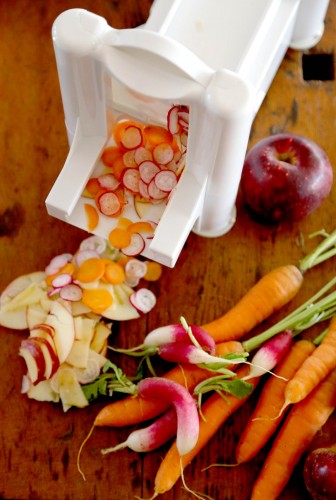I know it might be too late now for Muscadines since it was a whopping 19 degrees outside our Asheville door this morning. But this celebrated southern native grape keeps well when refrigerated, and as of Monday, growers at the WNC farmer’s market still had some baskets stashed away. If you live around the Asheville area, you really should run over there this very second and grab them … or be ready for their arrival next fall. Since Thanksgiving is truly the only American holiday that celebrates our legendary native foods, deep purple Muscadines fit in nicely, bestowing a splash of vibrant healthful bling to the festive table.
Muscadine grapes grow from West Virginia clear down to Florida, but North Carolina lays claim to the origins of this voluptuously-flavored southern belle. The bronze-skinned Scuppernong variety was discovered/found growing, by colonists in the mid 1500s. The term Muscadine refers to both the black cultivar (my particular favorite) and the greenish/bronze varieties, but most folks call the black ones Muscadines and the greenish bronze ones Scuppernongs. I’m no expert but there are a LOT of people who are, namely these North Carolinians and these.
I sauce the grapes and then water-bath can several versions of the innards. First wash, de-stem, and put them in a non-aluminum pot. This 5 quart pot holds about 5 pounds of grapes. Do NOT add any water. Squish the grapes however it suits you, the guts are green. Notice the matching pot.
Cook on medium/low heat until a pulp is formed. Which is beyond beautiful. And fragrant.
At this point, you will need to find some way to remove the very thick skins and seeds. I use a food mill with removable blades, which I recommend you have on hand … especially if you do any jam-making or tomato saucing. This one is an OXO, which never fails me, and there are lots of others. Use the medium blade for this adventure.
Don’t discard the skins and seeds just yet. Boil in a bit of water for a few minutes, strain and save for light sipping. Meanwhile, in your blue bowl, you will find grape pulp on the bottom with a layer of juice on the top. If you like, pour off the juice and save it to make sorbet (freeze or water-bath can) or jelly. Return the remaining pulp to the pot and continue to cook until it thickens a bit. Do not leave the room and burn your Muscadine sauce. It’s sweet and it will scorch, believe you me. You can sweeten the sauce with a bit of cider syrup (reduced fresh cider), honey, etc. But I like mine as-is. It’s wonderful on farmhouse-style cheese, in a salad dressing (recipe below), or as a marinade for chicken or pork or other meats. Or purple tofu.
To make a drop-dead gorgeous salad dressing out of ingredients you probably can’t get (I’m sorry!) Mix one part toasted walnut oil from a 900 year old Italian alpine mill to three parts Muscadine sauce, a squeeze of fresh lemon juice and some fresh pepper and coarse salt. A vinaigrette of cider vinegar, cider syrup, and any toasted nut oil is a good stand-in. (PS store toasted nut oils in the fridge, they will go rancid quickly.)
Thinly slice radishes, carrots, and crisp apple using a knife or a ridiculous gizmo like this one that makes zucchini noodles or curly fries. You definitely do NOT need one of these; what was I thinking. Even though I love it.
Drizzle the dressing onto your salad and top with toasted walnuts. Or just come over to our house and I’ll make you this salad.
And, in case you find yourself in the teensy alpine village of Roncobello, north of Bergamo, Italy … go visit the ancient Mulino de Baresi, where alpine residents milled corn, walnut oil, made cheese, strained honey and baked bread all in this one-stop mother of all mills up until 1997. I’ll tell you about it next week.










